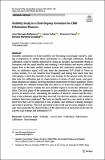Por favor, use este identificador para citar o enlazar a este item:
http://hdl.handle.net/10261/280048COMPARTIR / EXPORTAR:
 SHARE SHARE
 CORE
BASE CORE
BASE
|
|
| Visualizar otros formatos: MARC | Dublin Core | RDF | ORE | MODS | METS | DIDL | DATACITE | |

| Título: | Visibility study in a chief-deputy formation for CMB polarization missions |
Autor: | Bermejo-Ballesteros, J.; Cubas, Javier; Casas-Reinares, F. J. CSIC ORCID ; Martínez-González, Enrique CSIC ORCID | Fecha de publicación: | 2022 | Editor: | Springer Nature | Citación: | The Journal of the Astronautical Sciences 69: 651-691 (2022) | Resumen: | Scientific instruments on board satellites are becoming increasingly sensitive, making it imperative to submit these instruments to a thorough calibration. In-flight calibration could be largely improved by using an ancillary microsatellite flying in formation with the main satellite and emitting a well-defined and known reference signal. Due to the main satellite attitude motion, the calibration satellite and therefore, its calibration signal, will only enter the instrument FoV (Field of View) at certain instants. It is not intuitive how frequently and during how much time this will happen, or how this depends on the scan strategy. In the present work, the available time for calibration and its characteristics in terms of total, mean, and maximum duration are studied, deriving analytical expressions for these quantities. These expressions are validated numerically and allow us to assess the impact of different scan strategies and to evaluate the most suitable region to locate the calibration satellite. The focal plane of the instrument is also modelled to evaluate the calibration process at detector level, calculating the number of detectors viewed and the direction of the polarized signal that they received. For this last analysis, only numerical methods have been employed. The tools are finally used in a case study in order to show how they can be employed to test, evaluate, and optimize scanning strategies and relative positions. The tools presented in this work can be easily adapted to evaluate more generally the characteristics of the observation of each point in the sky for a given scan strategy and instrument FoV. | Versión del editor: | https://doi.org/10.1007/s40295-022-00325-z | URI: | http://hdl.handle.net/10261/280048 | DOI: | 10.1007/s40295-022-00325-z | E-ISSN: | 2195-0571 |
| Aparece en las colecciones: | (IFCA) Artículos |
Ficheros en este ítem:
| Fichero | Descripción | Tamaño | Formato | |
|---|---|---|---|---|
| visibimissi.pdf | 7,09 MB | Adobe PDF |  Visualizar/Abrir |
CORE Recommender
SCOPUSTM
Citations
1
checked on 11-abr-2024
WEB OF SCIENCETM
Citations
1
checked on 26-feb-2024
Page view(s)
40
checked on 23-abr-2024
Download(s)
18
checked on 23-abr-2024
Google ScholarTM
Check
Altmetric
Altmetric
Este item está licenciado bajo una Licencia Creative Commons

